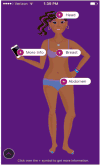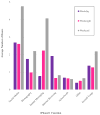Girl Talk: A Smartphone Application to Teach Sexual Health Education to Adolescent Girls
- PMID: 27393638
- PMCID: PMC5613288
- DOI: 10.1016/j.jpag.2016.06.011
Girl Talk: A Smartphone Application to Teach Sexual Health Education to Adolescent Girls
Abstract
Study objective: Produce Girl Talk, a free smartphone application containing comprehensive sexual health information, and determine the application's desirability and appeal among teenage girls.
Design, setting, participants, and interventions: Thirty-nine girls ages 12 to 17 years from Rhode Island participated in a 2-phase prospective study. In phase I, 22 girls assessed a sexual health questionnaire in focus groups. In phase II, 17 girls with iPhones used Girl Talk for 2 weeks and answered the revised sexual health questionnaire and interview questions before and after use.
Main outcome measures: Participants' responses to the sexual health questionnaire, interviews, and time viewing the application were used to determine feasibility and desirability of Girl Talk.
Results: Girl Talk was used on average for 48 minutes during participants' free time on weekends for 10- to 15-minute intervals. Reported usefulness of Girl Talk as a sexual health application from baseline (6 participants) to follow-up (16 participants) increased significantly (35.3% vs 94.1%; P < .001). Knowledge improved most in topics related to anatomy and physiology (70.5% to 74.7% out of 7 questions), sexuality and relationships (76.5% to 80.0% out of 10 questions), and STI prevention (75.6% to 79.0% out of 7 questions). Most phase II participants (13 out of 17, or 76.5%) were exposed to sexual health education before using Girl Talk, but 16 out of 17 participants (94.1%) stated that the application provided new and/or more detailed information than health classes.
Conclusion: Girl Talk can potentially connect teenage girls to more information about sexual health vs traditional methods, and participants recommended the application as a valuable resource to learn about comprehensive sexual health.
Keywords: Adolescent; Health care smartphone applications; Health education; Prospective studies; Reproductive health; Sexual behavior; Sexually transmitted diseases; Surveys and questionnaires.
Copyright © 2016 North American Society for Pediatric and Adolescent Gynecology. Published by Elsevier Inc. All rights reserved.
Conflict of interest statement
No conflicts of interests were involved in the work described in this manuscript.
Figures
References
-
- Developing Sexual Health Programmes: A Framework for Action (PDF) World Health Organization Department of Reproductive Health and Research; 2010.
-
- Alford S. Sex Education Programs: Definitions & Point-by-Point Comparison. Transitions: The Controversy over Abstinence-Only-Until-Marriage Programs. 2001;12:3–4.
-
- Sanfilippo JS, Davis A, Hertweck SP. Obstetrician gynecologists can and should provide adolescent health care. ACOG Clin Rev. 2003;8(7):1,15–16.
-
- Adolescence 11–21 Years (PDF) Bright Futures Guidelines for Health Supervision of Infants, Children and Adolescents. 2015:231–298.
-
- Kann L, Kinchen S, Shanklin S, et al. Youth Risk Behavior Surveillance — United States, 2013. Surveillance Summaries. 2014;63(4):1–167. - PubMed
MeSH terms
Grants and funding
LinkOut - more resources
Full Text Sources
Other Literature Sources




